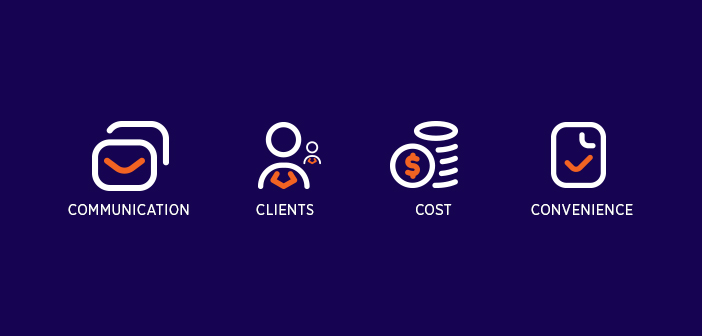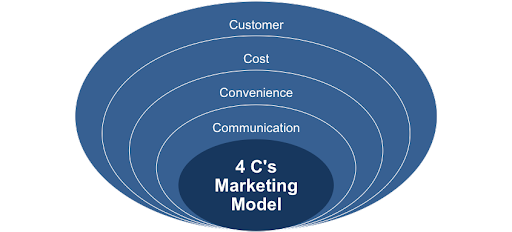
If you often follow marketing publications and online forums, you might have heard the buzzword “4Ps” many times. The elements of 4Ps are product, price, promotion, and place (distribution). Over time, the marketers come up with arguments and suggestions to improve and expand the 4Ps approach and its concept. One criticism of the 4Ps approach is that it does not focus on people (i.e., employees), even though they are essential, especially in the context of personal selling in the business-to-business (B2B) market. Therefore, the marketing experts introduced many theories; one of those is the proposition of an alternative 4Cs of marketing.
The introduction of 4Cs of marketing has created a considerable change in business practices. You might see the 4C model float around in the NFT marketing world, but have you wondered what it is and how to understand its implications fully?
If you have, it is high time to shed light on what “4Cs of marketing” exactly means and how it works in this ever-changing business age.
An Overview of the 4Cs Marketing Model
Developed in 1990 by Robert Lauterborn, the 4Cs of marketing is an updated classification system of the 4Ps. His 4Cs of marketing model has shifted the focus from producers to consumers, and become a better blueprint for smaller businesses that are marketing to a niche audience.
The background to the emergence of 4Cs of marketing idea was that more and more businesses produced goods, but they could not sell all. Through its focus on the customer, the 4Cs of marketing model is a step away from the traditional mass marketing concept. In mass marketing, companies selling a product tend to view audiences as just “a large featureless mass,” with no in-depth understanding of what the customer wants from a product. The 4Cs of Marketing model diverts action towards niche marketing instead, where the conversation is closer to one-to-one, and it requires more effort to understand who the customer is and what their actual needs are.

Instead of adding new elements, Lauterborn’s 4Cs of marketing provide a different and contemporary view of the classic 4Ps marketing mix. Fundamentally, the 4Cs of marketing emphasizes the importance of consumer focus with the approach to the marketing mix. It starts from the perspective of a modern and well-informed consumer who faces up with a vast choice of products and services in oversaturated markets.
What are the 4Cs of Marketing?
In Lauterborn’s opinion, the 4Ps model is no longer relevant and useful to help today’s marketer address any real issues. He listed the variables he felt were necessary instead. He began the 4Cs of marketing model with “consumer wants and needs” as the critical focus for product-driven companies that tend to make products that the customer does not want. His second ‘C’ of marketing is the “cost to satisfy” based on the irrelevance of the price among many factors. The third factor is the “convenience to buy,” which is an exciting concept in hustling work and life nowadays. The last variable of the 4C model is “communication,” with a proposal that instead of a more available and manipulative promotion, communication should remain a two-way dialogue process between the customer and the company.
Consumers’ Wants and Needs
According to the 4Cs of marketing, instead of beginning the story with a product itself, the focus should be on selling only what the customer especially wants to buy. You can’t manufacture products and then try to sell them to a mass market. An excellent example of this is probably Nokia, making a lot of products, but failing to satisfy customer needs and wants.
The marketing process requires marketers to spend time studying what customers want and need, and then attract them one by one with something each one wants. Only with this detailed understanding, a company will manage to sell with accuracy what the customers want to buy.

Of course, at the core of any marketing strategy is the product itself, however, this is just the tip of an iceberg, as the product must be something that customers find desirable. Also, there must be something unique about your products, which helps them stand out from all the rest of the competitors. The most effective steps to achieve this are:
- Understanding your target customers as well as the right untapped market
- Be clear about your value of products and develop the product instead of trying to fit a ready-made product into the market
- Product testing becomes a critical element of both the product variable and the custom variable.
There is a saying that exactly matches this ‘first C of marketing’, and it is “If you build it, they will come.” In most cases, you have to find out what people want and then “build” it for them; as a result, they will come to buy from you.
Cost to Satisfy
When understood correctly, the cost variable provides more information about the customer than the price does. Price is only a part of the total cost incurred to satisfy customers’ wants and needs. The customer bears much more expenditure in acquiring your goods and services. The cost subset of 4Cs of the marketing model includes both monetary and non-monetary costs. Below are some of them:
- Price – the amount of money that a consumer is willing to pay to acquire a good or service.
- The additional cost of acquiring – extra charges that might incur when you buy products (gas to drive to seller’s location, time and money spent on researching the products)
- Cost of conscience – imagine you are running a business that sells cakes that contain pork oil. Your Muslim consumers might incur a cost of conscience when they buy and eat your cakes.
- Opportunity cost – this refers to a benefit your consumer could have received but gave up to purchase your products and services.

Many marketers misunderstand that the primary motivation for product purchase is the price; however, if the given price undercuts the cost to gain the market, the company will be at a disadvantage. Instead, a focus on value to satisfy consumer’s wants or needs will appreciate essential information than just the purchase price. An emphasis on this factor of marketing will open the door for companies to increase the rate of their items while decreasing the cost to satisfaction through measures that have a minimal influence on the company’s bottom line.
Convenience to Buy
The third factor in the 4Cs marketing model according to marketing experts, is the convenience to buy, not the place or distribution only. Convenience to buy is an exciting concept when we live in a 24/7 always-on world. The proliferation of eCommerce, credit cards, and smartphones has made the provision of products to the customer a whole new game. A customer is free to visit a physical location to meet a need, as the concept of shopping from 9 a.m to 5 p.m has gone.

The emergence of different shopping channels and the ease of access requires marketers to focus on:
- Providing convenience through constant change and adaptation, rather than traditional and rigid distribution channels
- Researching and finding out all the potential channels on which customers might consider while making a purchase
- Detecting and removing all the barriers your customers face while buying your products and services
Businesses often ignore the convenience aspect of the 4C model, as they prioritize higher profit margins over the customer’s convenience, however, in the long run, convenience to consumers may bring back more benefits to the brand.
Communication
Meanwhile, a traditional marketing mix uses promotion as a tool to put all information about products and services in front of the customers; it still seems hard to a niche market. That is the reason why communication – the last one of the 4C model – is more favorable. With the development of the internet and social media, communication operates as a much broader focus on the entire buying experience.

In that regard, the 4Cs of marketing model works toward establishing a dialogue with the prospects, understanding their wants and needs, and urging them to take action immediately. There is more than just a “give-and-take” relationship between buyer and seller. Considering advertising as a form of communication can help a marketer understand their audiences better, which indirectly contributes to boosting sales and customer loyalty.
Conclusion
The 4Cs of marketing is an integral part of the process of planning and executing in any business firm, as it suits better to the needs of smaller businesses that haven’t had strong brand name equity. Besides, people should not regard the 4Cs model as the replacement for the traditional 4Ps marketing mix, as together they can help businesses balance meeting goals and objectives with responding to the changing needs of their customers.
No matter if you are using the 4Ps, the 7Ps, or the 4Cs of marketing model, the key point to remember is to identify and understand target consumers as well as their wants and needs. And then, you can offer tailored products and services that are meaningful to them and can lead to increased sales.
Author Bio:
Haley is a content creator at Avada Commerce. When not working and learning about eCommerce, she gets hung up on travel adventures, food, and books. Growing up, she wants to read, learn, and experience more and more up-to-date things to adapt to this ever-changing world.

